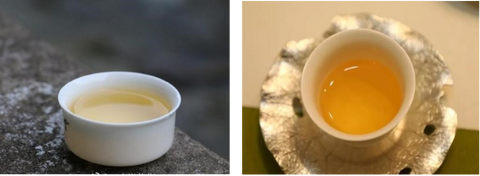
What is cloudy after cold in black tea?
- What is cloudy after cold?
- What is the reason for the formation of cloudy after cold?
- Do all teas appear cloudy after cold?
- What is the relationship between cloudy after cold and the quality of tea?
- Can we still drink tea that produces cloudy after cold?

So let's start with our first point today, what is a cloudy after cold? I don't know if you have noticed a phenomenon. When we are making tea, especially black tea, we pour a cup of black tea for tea friends in the tea room. If the tea friends don’t drink it in time, after the tea soup is cold, we will find that the original orange-yellow and bright soup color will turn a little turbid. So this is what we call cloudy after cold.
In fact, it is cloudy after cold, which refers to the light brown or orange milky turbidity that appears after the tea soup is cooled. What about this phenomenon?
It is also called "cold hind muddy" or "tea cheese" by us. So after talking about what is Leng Houmu, let's talk about the internal reasons for the formation of cloudy after cold?
We all know that there are many ingredients in tea, one of which has a common chemical structure, collectively called tea polyphenols, and dozens of them have been identified. In unprocessed tea leaves, most of the tea polyphenols exist in the form of catechins. Sufficient oxidation is required in the production of black tea, many catechins will be converted into theaflavins, and some will be further converted into thearubigins. Theaflavins and thearubigins are the main factors that bring orange and bright tea soup to black tea.
Then after our black tea is cooled, there will be turbidity in varying degrees (some are not obvious), but we can basically see it with the naked eye, and its material basis is the combination of theaflavin, thearubigin and caffeine complexes.
So what are complexes? Now it is also called a coordination compound. In simple terms, it means that several substances are connected together and maintain good stability with each other. Under certain conditions, they will decompose and complex (connect together), such as heating It will be complexed, and cold water will decompose.
When making tea, the solubility of theaflavins is largely affected by the water temperature. The temperature of our tea soup is relatively high
At that time, theaflavins are in their free state and dissolved in hot water, making the tea soup clear and translucent. However, as the temperature of the tea soup gradually becomes lower and cooler (below 40°C), theaflavins will form a complex in the form of "tucking and pushing", that is, the phenomenon of "cold and muddy".
So in addition to theaflavins, caffeine is also one of the reasons for the formation of "cold turbidity". The combination product of theaflavin and caffeine has lower solubility and is easier to get together and become larger, resulting in the appearance of cold aftertaste. Therefore, many people believe that the cold aftertaste is the result of the reaction between theaflavins and caffeine.
However, caffeine is not the main factor. The main reason for the formation of "cold turbidity" is the content of theaflavins. The more this content is, the easier it is to form cold turbidity.
Scientific experiments have confirmed that if the caffeine is removed, theaflavins will still cause "cold aftertaste". The higher the theaflavin content of a tea, the easier it is to have cold aftertaste.
Well, after we have finished talking about the causes of the cold and muddy, let's talk about the third point today, is it all
All teas will appear cloudy after cold. We mentioned earlier that the main reason for the formation of cloudy after cold is to see the content of theaflavins. At the same time, as the temperature of the tea soup gradually decreases and cools (below 40°C), the tea The flavin will form a complex in the form of "Zhatui", that is, the phenomenon of "cold and muddy".
So that is to say, as long as there are theaflavins in tea, there may be a phenomenon of cold aftertaste under low temperature conditions. For example, our rock tea, Shengpu, etc. will have such a situation. Well, I have a comparative research report here, and there is a report about the proportion of theaflavins in large teas:
Then we can see from the picture that among the six major teas, the total amount of theaflavins in our black tea is the highest. That's why, we hear or learn more about the reason of cold aftertaste from black tea, because it has such a basic condition. It is also the most likely to present.
At the same time, I would like to add here: What we call cold muddy is the phenomenon of "cold muddy" when the tea is cooled down by theaflavins.
Why add this point? We can't simply understand the turbidity of tea soup as the turbidity of tea soup, because there are many factors that affect the turbidity of tea soup. In addition to the cloudy tea soup caused by theaflavins, there are also factors caused by processing technology or tea tree varieties. Condition:
- Turbidity caused by the process.
Too much broken tea caused by over-drying and over-kneading will also cause turbidity in the tea soup. It may exist in teas with finishing and rolling processes, such as green tea, oolong tea, black tea, etc.
- For example, the turbidity caused by the tea cents due to the variety of the tea tree.
This is caused by the fluff on the tea buds falling off during brewing. More common in curly and fuzzy famous stars
green tea. This kind of turbidity will appear when the tea soup is hot, and it will not affect the quality. So these are not the normal cold and muddy phenomena we are talking about.
After we have finished talking about this, let's talk about the relationship between Lenghouhun and the quality of black tea?
So where is the quality of black tea mainly reflected? Appearance, soup color, aroma, taste, leaf bottom. these 5 areas
Then theaflavins are orange-yellow and astringent pigments in black tea. Its content accounts for 1% to 2% of black tea solids, and it is also an important component of black tea's taste intensity and freshness. Thearubigin is also an important component of the taste of tea soup, and together with theaflavin, it constitutes the "taste and mouthfeel" of black tea.
Then if the content of theabrownin is too high, the taste will become lighter. According to the research of the correlation coefficient, it is found that the more theaflavin and thearubigin content, the brighter and brighter the red color of the tea soup, and the better the quality of the tea; the higher the theabrownin content, the darker the soup color, and the worse the quality of the tea. And the content of these three is the relationship of "one ebb and flow".
Therefore, the degree and color of "cold muddy" are positively correlated with the quality of black tea. Is there "cold muddy" and what is the color of "cold muddy"? It mainly depends on the content of theaflavins.
Only when the content of theaflavins in black tea is high, it is easy to produce "cold muddy", and the color of "cold muddy" is bright yellow to orange. If the theaflavin content is too low, it is not easy to produce "cold muddy", even if "cold muddy", its color is often dark yellow paste color.
Therefore, the color after the formation of "cold and muddy" is the appearance of good quality black tea, which can be used as a method to judge the quality of black tea.
But it should be noted here that this is only a method, and in this method we still need to see whether the color of the muddy after cold is normal. I'm feeling like we're going to go through the entrance eventually. The feeling of entrance is the most real.
So after we have finished talking about the relationship between Lenghoumu and the quality of black tea, let me talk about the issue we are most concerned about, can we still drink the tea soup that produces Lenghoumu?
Before answering this question? Let me first answer what effect theaflavin, the main element that produces cold aftertaste, has on our body.
According to clinical trials, theaflavins have at least the following five main functions and effects on the human body:
- Theaflavins have a unique maintenance function on the cardiovascular system;
- Theaflavins can inhibit gene mutations, thereby preventing and fighting cancer;
- Antioxidant effect of theaflavins;
- Theaflavins are antibacterial and antiviral;
- Theaflavins are anti-radiation, weight loss, beauty and anti-inflammation.


